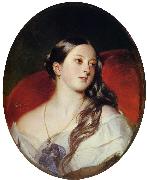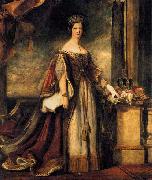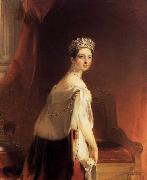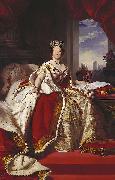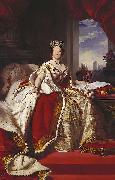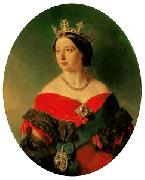Wholesale Oil Painting No Minimum |
|||||||||||
|
|
|||||||||||

|
|||||||||||
|
|
|
||||||||
Franz Xaver WinterhalterGerman 1805-1873 Franz Xaver Winterhalter Galleries German painter and lithographer. He trained as a draughtsman and lithographer in the workshop of Karl Ludwig Scheler (1785-1852) in Freiburg im Breisgau and went to Munich in 1823, sponsored by the industrialist Baron Eichtal. In 1825 he began a course of study at the Akademie and was granted a stipend by Ludwig I, Grand Duke of Baden. The theoretical approach to art of the Akademie under the direction of Peter Cornelius was unfamiliar to him, as in Freiburg he had been required to paint in a popular style. He found the stimulus for his future development in the studio of Joseph Stieler, a portrait painter who was much in demand and who derived inspiration from French painting. Winterhalter became his collaborator in 1825. From Stieler he learnt to make the heads of figures emerge from shadow and to use light in the modelling of faces. He moved to Karlsruhe in 1830 with his brother Hermann Winterhalter (1808-92), who had also trained with Scheler and had followed him to Munich. |
||||||||
|
|
||||||||
Queen Victoria
Queen Victoria Painting ID:: 572 |
1843 1843 |
|||||||
|
|
||||||||
Sir David Wilkie1785-1841 British Sir David Wilkie Galleries Wilkie may have inherited his rectitude and tenacity, even his nervous inhibitions, from his father, the minister of his native parish. Though little responsive to schooling, he showed an early inclination towards mimicry that expressed itself in drawings, chiefly of human activity. In these he was influenced by a copy of Allan Ramsay pastoral comedy in verse, the Gentle Shepherd (1725), illustrated by David Allan in 1788. One of the few surviving examples of his early drawings represents a scene from it (c. 1797; Kirkcaldy, Fife, Mus. A.G.). Wilkie cherished the demotic spirit of this book and its illustrations throughout his life. |
||||||||
|
|
||||||||
|
|
Queen Victoria
Queen Victoria Painting ID:: 62452 |
1840 Oil on canvas Private collection Author: WILKIE, Sir David Title: Queen Victoria (detail) Form: painting , 1801-1850 , Scottish , portrait 1840 Oil on canvas Private collection Author: WILKIE, Sir David Title: Queen Victoria (detail) Form: painting , 1801-1850 , Scottish , portrait |
||||||
|
|
||||||||
Thomas Sully1783-1872 Thomas Sully Galleries Sully became a professional painter at age 18 in 1801. He studied face-painting under Gilbert Stuart in Boston for three weeks. After some time in Virginia with this brother, Sully moved to New York, after which he moved to Philadelphia in 1806, where he resided for the remainder of his life. In 1809 he traveled to London for nine months of study under Benjamin West. Sully's 1824 portraits of John Quincy Adams, who became President within the year, and then the Marquis de Lafayette appear to have brought him to the forefront of his day. (His Adams portrait may be seen in the National Gallery of Art, Washington.) Many famous Americans of the day had their portraits painted by him. In 1837-1838 he was in London to paint Queen Victoria at the request of Philadelphia's St. George's Society. His daughter Blanche assisted him as the Queen's "stand-in", modeling the Queen's costume when she was not available. One of Sully's portraits of Thomas Jefferson is owned by the Jefferson Literary and Debating Society at the University of Virginia and hangs in that school's Rotunda. Another Jefferson portrait, this one head-to-toe, hangs at West Point, as is his portrait of Alexander Macomb (American general). Sully's own index indicates that he produced 2631 paintings from 1801, most of which are currently in the United States. His style resembles that of Thomas Lawrence. Though best known as a portrait painter, Sully also made historical pieces and landscapes. An example of the former is the 1819 Passage of the Delaware, now on display at the Museum of Fine Arts, Boston. |
||||||||
|
|
||||||||
|
|
Queen Victoria
Queen Victoria Painting ID:: 62500 |
1838 Oil on canvas, 143 x 113 cm Wallace Collection, London This painting is a reduced version of a whole-length portrait of the young Queen at the time of her coronation which was painted in London for the Society of the Sons of St George of Philadelphia. Author: SULLY, Thomas Title: Queen Victoria Form: painting , 1801-1850 , American , portrait 1838 Oil on canvas, 143 x 113 cm Wallace Collection, London This painting is a reduced version of a whole-length portrait of the young Queen at the time of her coronation which was painted in London for the Society of the Sons of St George of Philadelphia. Author: SULLY, Thomas Title: Queen Victoria Form: painting , 1801-1850 , American , portrait |
||||||
|
|
||||||||
Franz Xaver WinterhalterGerman 1805-1873 Franz Xaver Winterhalter Galleries German painter and lithographer. He trained as a draughtsman and lithographer in the workshop of Karl Ludwig Scheler (1785-1852) in Freiburg im Breisgau and went to Munich in 1823, sponsored by the industrialist Baron Eichtal. In 1825 he began a course of study at the Akademie and was granted a stipend by Ludwig I, Grand Duke of Baden. The theoretical approach to art of the Akademie under the direction of Peter Cornelius was unfamiliar to him, as in Freiburg he had been required to paint in a popular style. He found the stimulus for his future development in the studio of Joseph Stieler, a portrait painter who was much in demand and who derived inspiration from French painting. Winterhalter became his collaborator in 1825. From Stieler he learnt to make the heads of figures emerge from shadow and to use light in the modelling of faces. He moved to Karlsruhe in 1830 with his brother Hermann Winterhalter (1808-92), who had also trained with Scheler and had followed him to Munich. |
||||||||
|
|
||||||||
|
|
Queen Victoria
Queen Victoria Painting ID:: 78839 |
1870(1870)
Medium Oil on canvas
Dimensions 242.5 x 156.9 cm (95.5 x 61.8 in)
cyf 1870(1870) Medium Oil on canvas Dimensions 242.5 x 156.9 cm (95.5 x 61.8 in) cyf |
||||||
|
|
||||||||
Franz Xaver WinterhalterGerman 1805-1873 Franz Xaver Winterhalter Galleries German painter and lithographer. He trained as a draughtsman and lithographer in the workshop of Karl Ludwig Scheler (1785-1852) in Freiburg im Breisgau and went to Munich in 1823, sponsored by the industrialist Baron Eichtal. In 1825 he began a course of study at the Akademie and was granted a stipend by Ludwig I, Grand Duke of Baden. The theoretical approach to art of the Akademie under the direction of Peter Cornelius was unfamiliar to him, as in Freiburg he had been required to paint in a popular style. He found the stimulus for his future development in the studio of Joseph Stieler, a portrait painter who was much in demand and who derived inspiration from French painting. Winterhalter became his collaborator in 1825. From Stieler he learnt to make the heads of figures emerge from shadow and to use light in the modelling of faces. He moved to Karlsruhe in 1830 with his brother Hermann Winterhalter (1808-92), who had also trained with Scheler and had followed him to Munich. |
||||||||
|
|
||||||||
|
|
Queen Victoria
Queen Victoria Painting ID:: 79489 |
1870(1870)
Medium Oil on canvas
Dimensions 242.5 x 156.9 cm (95.5 x 61.8 in)
cyf 1870(1870) Medium Oil on canvas Dimensions 242.5 x 156.9 cm (95.5 x 61.8 in) cyf |
||||||
|
|
||||||||
Franz Xaver WinterhalterGerman 1805-1873 Franz Xaver Winterhalter Galleries German painter and lithographer. He trained as a draughtsman and lithographer in the workshop of Karl Ludwig Scheler (1785-1852) in Freiburg im Breisgau and went to Munich in 1823, sponsored by the industrialist Baron Eichtal. In 1825 he began a course of study at the Akademie and was granted a stipend by Ludwig I, Grand Duke of Baden. The theoretical approach to art of the Akademie under the direction of Peter Cornelius was unfamiliar to him, as in Freiburg he had been required to paint in a popular style. He found the stimulus for his future development in the studio of Joseph Stieler, a portrait painter who was much in demand and who derived inspiration from French painting. Winterhalter became his collaborator in 1825. From Stieler he learnt to make the heads of figures emerge from shadow and to use light in the modelling of faces. He moved to Karlsruhe in 1830 with his brother Hermann Winterhalter (1808-92), who had also trained with Scheler and had followed him to Munich. |
||||||||
|
|
||||||||
|
|
Queen Victoria
Queen Victoria Painting ID:: 85284 |
Date 1856(1856)
Medium Oil on canvas
Dimensions 88.6 x 72.2 cm (34.9 x 28.4 in)
cjr Date 1856(1856) Medium Oil on canvas Dimensions 88.6 x 72.2 cm (34.9 x 28.4 in) cjr |
||||||
|
|
||||||||
|
Franz Xaver Winterhalter German 1805-1873 Franz Xaver Winterhalter Galleries German painter and lithographer. He trained as a draughtsman and lithographer in the workshop of Karl Ludwig Scheler (1785-1852) in Freiburg im Breisgau and went to Munich in 1823, sponsored by the industrialist Baron Eichtal. In 1825 he began a course of study at the Akademie and was granted a stipend by Ludwig I, Grand Duke of Baden. The theoretical approach to art of the Akademie under the direction of Peter Cornelius was unfamiliar to him, as in Freiburg he had been required to paint in a popular style. He found the stimulus for his future development in the studio of Joseph Stieler, a portrait painter who was much in demand and who derived inspiration from French painting. Winterhalter became his collaborator in 1825. From Stieler he learnt to make the heads of figures emerge from shadow and to use light in the modelling of faces. He moved to Karlsruhe in 1830 with his brother Hermann Winterhalter (1808-92), who had also trained with Scheler and had followed him to Munich. Queen Victoria Date 1856(1856) Medium Oil on canvas Dimensions 88.6 x 72.2 cm (34.9 x 28.4 in) cjr |
||||||||
|
|
||||||||
|
Prev Next
|
||||||||
|
|
||||||||
|
Related Paintings to Franz Xaver Winterhalter :. |
||||||||
|
|
||||||||
|
CONTACT US |
